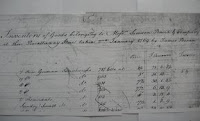
As an artist, you create with passion, perhaps boundless energy and freedom. Untouchable, you flow deeper into your work. You think you have left the mindless paper work at the office far behind to pursue your true calling called ART... Well, what if I told you that your true calling also requires a paper trail. That there are Excel files to create, mailings to put out, and numbers to crunch. Before you turn your iPod all the way up, or switch back over to YouTube, please realize that this is something you can handle. Keeping an inventory of your work is not going to taint its integrity, it doesn't turn you into "the Man," and it may even bring you more peace of mind and greater financial gain. Today, I am covering the basics of inventory and what it means for your art career.
I know it is a struggle for some to find the time to create art, let alone properly document it and manage an up to date inventory, but it is something that needs to get done. There are many ways to tackle this task. The reason for doing inventory isn't to show off your business smarts or exercise your left brain. I believe the act of counting all your work and knowing where it is and where it has gone is comforting, and frees up creative energy that is spent trying to keep up with all this chatter in your head. So, I highly recommend taking the time to start an inventory, or if you already have one, make sure it is kept up to date. The process will actually free you and create more time to do what you really love.
I must say that the job of inventory is much easier to accomplish if you do this regularly and break it down into small chunks, so that you will not have to spend a whole day, week, or month trying to remember who bought what, which gallery has that, and how much you got paid. If you are a professional artist, you must keep up with all of this. Come tax time, you will be so pleased that you kept such good records.
I highly recommend beginning this process even if you are just starting out. For example, when you sell a painting to a friend or at some "under the table" art event, even if you trade/donate/or give art as gifts, keep up with where it is going. These records will help you build faith in yourself, and the information that you record will help your career in many ways. This information can be used to create : a mailing list of your clients, thank you cards, keeping track of how much money you are making per month, and how many paintings you are selling. Keeping an inventory of all of these details helps you note trends as well, you can see which paintings are selling or what pieces clients' gravitate toward, who makes up your client base, and how the galleries that represent you are doing as far as selling your work. Another surprising benefit of documenting and keeping inventory of your work, is that it serves as an unbroken link to the work, and it may help you part with your art easier, especially if you are just starting out or are very emotionally attached to a particular work.
So lets get into the nuts and bolts of keeping an inventory. It can be as simple and old school as pen and paper or as hard and technologically savvy as you want it to be. Some basic elements of inventory are:
- Title of art ( or you can assign a number or both)
- Date of completion, ( year is about as detailed as I get)
- Medium, Size
- Price ( and how much you earned from the work)
- Where the work was exhibited ( this could be several places)
- Who purchased the work ( name, address, and phone, email and venue they purchased through)
- If the work is in your studio take note, when it leaves your studio take note of that as well
- If you are really savvy you may include a photo of the work in your inventory records
- You may also want to digitally archive your exhibits, by burning all the images onto a CD, with the date of the show, curator, location etc.
Being an artist is a wonderful and fulfilling career path, and with any job come the responsibilities that aren't always fun but are necessary and vital, keeping an inventory of your art is one of those tasks. It might seem unpleasant and arduous but if you can keep up with it you will be richly rewarded creatively and financially.
Good Luck!
Some resources that have helped me are:
Art Marketing 101 : A Handbook for the Fine Artist by Constance Smith
Art Office: 80+ Business Forms, Charts, Sample Letters, Legal Documents and Business Plans by Constance Smith and Sue Viders
http://www.artworkspro.com
affordable, computerized art inventory data base
Paper, pen and my mind

Great advice! When did you become such a grown up? I'm not near so organised - I can't even manage a grocery list without losing it before I get to the shops.
ReplyDelete